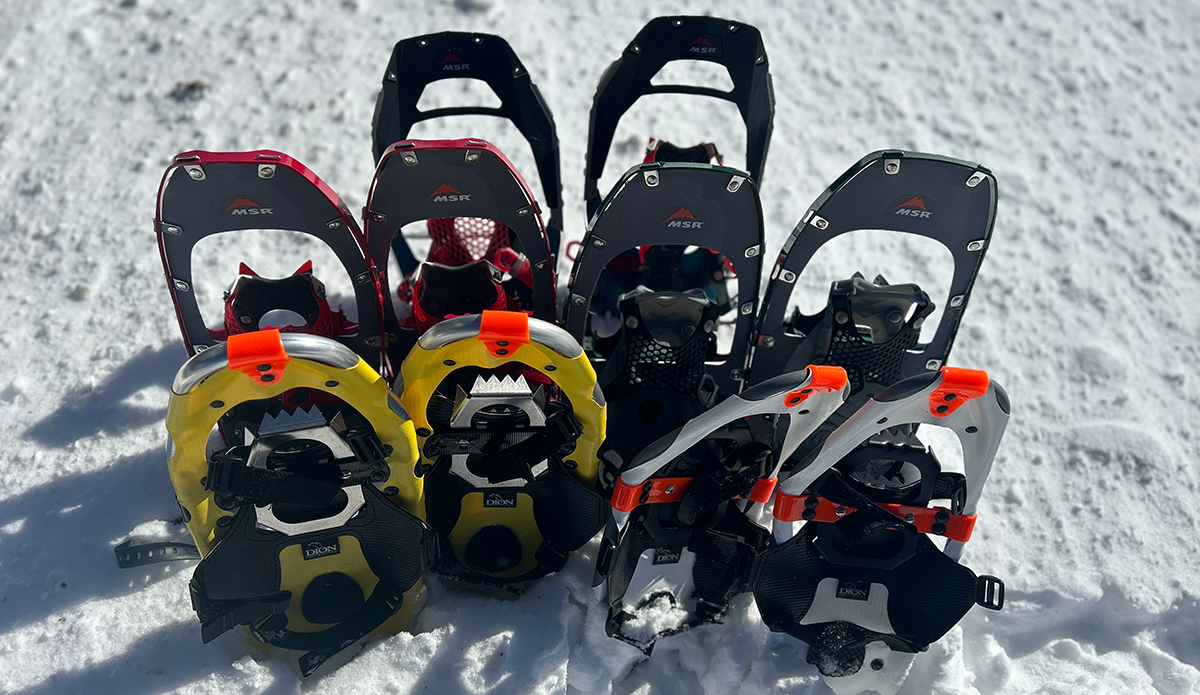
We tested some of the best snowshoes on the market to help you find the right pair for your experience level, budget, and use case. Photo: Rebecca Sperry/The Inertia
Snowshoes have come a long way from the birth of recreational snowshoeing in the mid-nineteenth century. Once cumbersome wood-framed shoes have continued to become lighter and more ergonomic over the last fifty years. Snowshoeing is a fantastic way to get outside in the wintertime, and depending on your skill level, there are a myriad of different styles of shoes designed to suit your needs.
However, with so many options, it can be overwhelming to decide which pair is right for you. Our expert snowshoers have been hitting the trails for over nine years, and we tested some of the most popular pairs to help bring you our top picks.
See our Comparison Table to see how all the snowshoes stack up against each other. Then scope out our Buyer’s Guide section for an in-depth discussion of how to choose the snowshoes that best meet your needs.
The Best Snowshoes 2024
Best Overall Snowshoes: MSR Revo Ascent Snowshoes
Best Budget Snowshoes: MSR Lightning Trail Snowshoes
Best High-Performance Snowshoes: MSR Lightning Ascent Snowshoes
Best Snowshoes for Trail Running: Dion 121 QuickFit Binding/Ice Cleat Snowshoes
Best Overall Snowshoes
MSR Revo Ascent Snowshoes ($320)

Availability: 22” and 25” men’s and women’s styles
Size Tested: 22” women’s
Weight: 4 lb 2 oz
Best For: All snowshoeing conditions (flat to steep terrain)
Pros: Ultra-durable frame and binding, 360 traction, easy-to-use heel lift, slightly less expensive than the comparable MSR Lightning Ascents
Cons: Slightly wider frame than we’d like despite being designed for a narrower stride, composite frame feels less rugged than an aluminum frame
The MSR Revo Ascent snowshoe is our favorite snowshoe overall and the snowshoe we would recommend for most people. It sports both aggressive traction and a heel-lift feature designed to reduce fatigue on sustained uphills. That combo makes them ideal for climbing steep trails with (or without) ice.
They are also perfect for keeping you afloat when breaking out a foot or more of fresh powder. The only con that we could find was in deck material choice. The polypropylene deck may not hold up to aggressive, rocky terrain over time.
What makes these snowshoes ideal is their versatility and adaptability to a wide array of terrain. For those interested in trying out snowshoeing for the first time on flat terrain, the MSR Revo Ascents will do the job. They are also the perfect option for the seasoned snowshoer heading up to break out a few feet of fresh snow. There were no issues when it came to floatation; these snowshoes weigh around 2 pounds per shoe (right in the average range for weight), and the binding was easy to use and reliable.
MSR is a reliable, well-known brand within the snowshoeing community, and the Revo Ascents lived up to its reputation. Due to their slightly lower price tag, the Revos narrowly beat out the MSR Lightning Ascents.
Check Price on REI Check Price on Amazon
Best Budget Snowshoes
MSR Lightning Trail Snowshoes ($280)
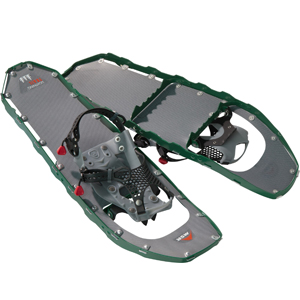
Availability: 22” and 25″ men’s and women’s styles
Size Tested: 22” women’s
Weight: 3 lb 3 oz
Best For: Rolling/flat Terrain
Pros: Binding straps have buckle tabs, which make adjustments much easier; under 4 pounds in weight
Cons: No heel lift, less ergonomic frame, cumbersome for a narrower stride.
The MSR Lightning Trail snowshoes are mid-tier snowshoes designed for snowshoeing on rolling or flat terrain. They have a durable design and minimal traction. But the real standout features are the binding and the price tag.
The Lightning Trails are the only MSR snowshoes we tested with the buckle tab binding. We prefer this binding to the strap design used on the more expensive pairs of MSRs. These tabs make adjusting the snowshoes much easier, even when wearing gloves or mittens.
While this is by no means the least expensive snowshoe on the market, it is the best budget option we tested that offers traction, even though its primary purpose is snowshoeing on flat or rolling trails. Furthermore, the wider frame makes this snowshoe ideal for individuals looking for better flotation without feeling cumbersome or clunky.The downside of the wider frame is that it might get in the way for individuals with a narrower stride.
Check Price on REI Check Price on Amazon
Best High-Performance Snowshoes
MSR Lightning Ascent Snowshoes ($390)
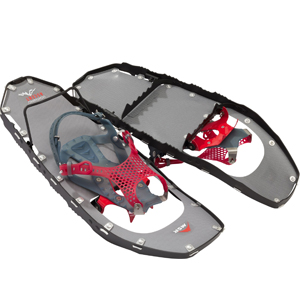
Availability: 22” and 25” men’s and women’s styles
Size Tested: 22″ women’s
Weight: 3 lb 13 oz
Best For: Hiking/Steep Terrain
Pros: Ultra-durable frame and binding, 360 traction, easy-to-use heel lift, lightest and narrowest of the three pairs of MSRs we tested
Cons: Frame is less ergonomic and can feel bulky on a narrower stride, most expensive snowshoes we tested.
The MSR Lightning Ascents are the snowshoes we’d recommend to outdoor enthusiasts who intend to snowshoe on steeper terrain as part of their winter recreation. They come standard with a heel-lift feature and aggressive 360-degree traction. Even better, their aluminum and TPU-coated nylon construction makes them tough enough to withstand icy, rocky trails.
In addition to being incredibly rugged, these snowshoes are a few ounces lighter than our best overall winner, the MSR Revos. The Lightning Ascents have the same binding system as the Revos and will keep your feet in place while being easy to adjust throughout the day, even when you’re wearing gloves.
What sets these snowshoes apart from the rest is their durability. Despite being lighter than the Revos, the Lightning Ascents are much more rugged and can withstand almost anything you throw at them. If you’re headed uphill and need traction that you can count on in icy conditions, these are the snowshoes for you.
Check Price on REI Check Price on Amazon
Best Snowshoes for Trail Running
Dion 121 QuickFit Binding/Ice Cleats (Starting at $260)
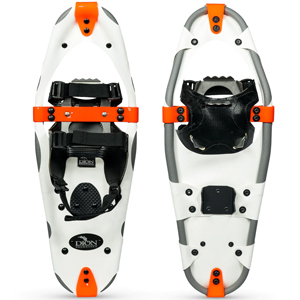
Availability: Small, regular, and large
Size Tested: Small
Weight: 2 lb 4 oz
Best For: Rolling/flat terrain/trail running
Pros: Ultra lightweight, binding is customizable, traction can be replaced
Cons: No heel lift, No front strap on the binding
The up-and-coming Dion 121 QuickFit Binding/Ice Cleat snowshoes are our top recommendation for ultra-athletes or trail runners looking to move light and fast. These snowshoes are fully customizable. In fact, when you receive your pair, they come with extra straps that you can swap out for a perfect fit.
These snowshoes are great for rolling and flat terrain. They also have some traction, which makes them an option for uphill snowshoeing. The traction can also be customized and replaced as needed.
The Dion 121s are hitting the trail running world hard and are some of the most popular trail running snowshoes out there because of their durability, uber-light weight, and customizability. However, for individuals looking for snowshoes that offer the added benefits of fatigue-reducing heel lift, these might not be the pair. They also aren’t ideal for breaking out a foot or more of snow. And with a lack of front straps on the bindings, we felt a little insecure on the downhills.
Check Price on DIONSnowshoes: Best of the Rest
Dion 132 QuickFit Binding/Ice Cleats (Starting at $240)
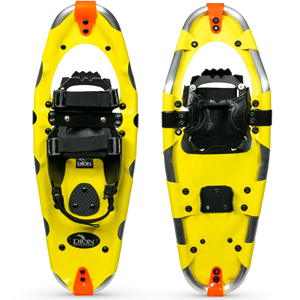
Availability: small, regular, and large
Size Tested: Small
Weight: 2 lb 13.1 oz
Best For: Rolling/flat terrain/trail running
Pros: Ultra lightweight, binding is customizable, traction can be replaced
Cons: No heel lift, no front strap on the binding
The Dion 132 QuickFit Binding/Ice Cleat snowshoes are very similar in design to the Dion 121s, which earned our Best Snowshoes for Trail Running award. These shoes have a slightly less curved frame than the Dion 121s, making them a bit less cumbersome to wear on rolling terrain. However, because they are slightly heavier, they didn’t beat out the 121s.
However, the 132s feature slightly more aggressive traction than the Dion 121s and are a bit less expensive. Because all of Dion’s snowshoes are fully customizable, there is no reason why you can’t switch your Dion 121’s traction with the more aggressive teeth found on the Dion 132s.
Check Price on DIONBest Snowshoes Comparison Table
| Snowshoes | Price | Weight | Best Use | Heel lift Yes/No | Availability |
| MSR Revo Ascent Snowshoes | $320 | 4lbs 2 oz | All-terrain | Yes | 22″ and 25″ men’s and women’s styles |
| MSR Lightning Trail Snowshoes | $280 | 3lbs 3 oz | Rolling/flat terrain | No | 22″ and 25″ men’s and women’s styles |
| MSR Lightning Ascent Snowshoes | $390 | 3lbs 13 oz | Hiking/steep terrain | Yes | 22″ and 25″ men’s and women’s styles |
| Dion 121 QuickFit Binding/Ice Cleat Snowshoes | $260 | 2lb 4 oz | Trail running, rolling/flat terrain | No | Small, medium, large |
| Dion 132 QuickFit Binding/Ice Cleats | $240 | 2lb 13.1 oz | Trail running, rolling/flat terrain | No | Small, medium, large |
How We Tested The Best Snowshoes
We tested these snowshoes in a variety of trail conditions and terrain. From flat, hard-packed trails to steep, unconsolidated snow, these snowshoes saw it all. Even some wonderfully sticky spring snow!
Throughout the testing process, we tried each pair of snowshoes with two types of hiking shoes: trail runners and hiking boots. All five pairs of snowshoes fit comfortably, regardless of shoe type.
Additionally, we made note of how well each pair of snowshoe bindings held our feet in place while not cutting off circulation (something snowshoes are notorious for doing). When testing, we judged traction, comfort, stability, ease of use, and other factors.
As an experienced outdoor enthusiast, our tester, Rebecca Sperry, has spent over nine winters hiking in the White Mountains of New Hampshire on some of the most rugged terrain in the United States. She hikes almost exclusively solo and has racked up over 6,000 miles of hiking. She is the 96th person to hike every trail in the White Mountain Guidebook (one of the most elite hiking challenges in the Northeast).

Our best overall winners, MSR Revo Ascents, are the perfect balance of ruggedness and flexibility. They can tackle any terrain — whether you’re snowshoeing on flat trails or climbing a mountain. Photo: Rebecca Sperry/The Inertia
Snowshoes Buyer’s Guide
How to Choose the Best Snowshoes
Finding the right style of snowshoe is one of the most important parts of having a pleasant outdoor experience in the winter. The first step in that process is determining what type of trail conditions you’ll be snowshoeing on. Typically, snowshoes are designed for three types of terrain: flat, rolling, and steep.
Snowshoes designed for flat terrain tend to be the least expensive, have fewer added features, and are less rugged.
Snowshoes designed for use on rolling terrain will be a bit more expensive and have mid-grade features like built-in heel lift and some traction.
Finally, snowshoes designed for steep terrain come with the most expensive price tag and the most aggressive traction. They also routinely feature heel lifts and sophisticated binding systems.
Running snowshoes are a newer category of snowshoes designed for trail running on flat or rolling terrain. They tend to be the lightest-weight snowshoes and don’t typically have added features like aggressive traction or heel lift.
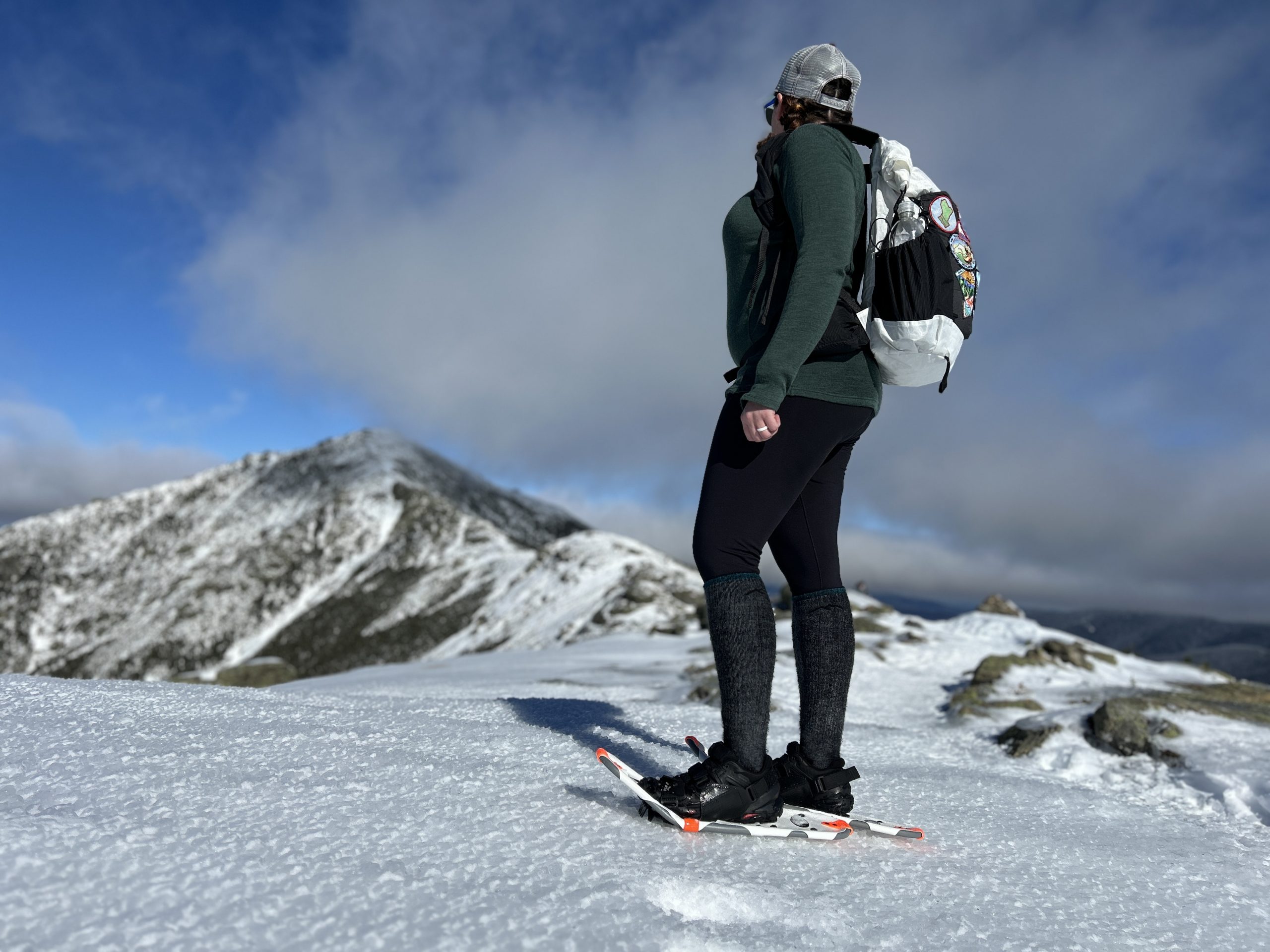
The personalized binding system on the Dion 121s and Dion 132s makes the brand a unique, forward-thinking player in the snowshoe realm. Photo: Rebecca Sperry/The Inertia
Choosing Snowshoes: Sizing
One of the main reasons for wearing snowshoes is to distribute your weight over a larger surface area so that you are less inclined to sink or post-hole.
When looking for the right pair of snowshoes, size is important. Snowshoes come in a variety of lengths and widths. Depending on your weight (with your backpack on), you will need a shorter or longer snowshoe. The less consolidated the snow is, the more likely you are to sink.
Longer snowshoes are designed for powdery trail conditions. Meanwhile, narrower, shorter snowshoes are designed for a more solidly packed trail.
When in doubt, it’s best to go with the pair appropriate for your weight, including your backpack, rather than focusing on the slight nuances of snowshoe length based on the snowpack.
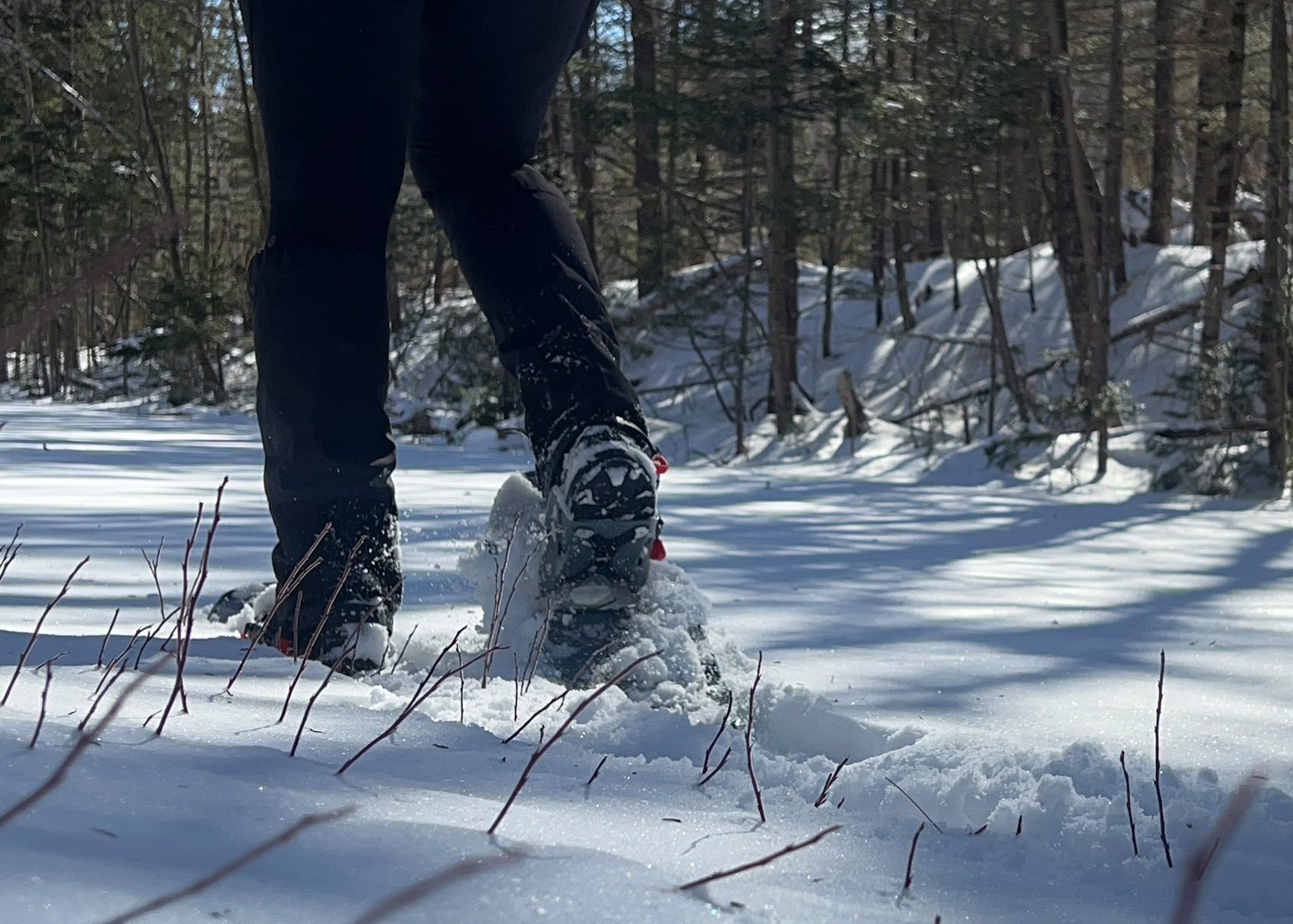
The MSR Lightning Trail snowshoes sport a wider frame designed for flat to rolling terrain and are the best bang for your buck without compromising quality. Photo: Rebecca Sperry/The Inertia
Choosing Snowshoes: Materials
Snowshoe frames come in several materials, but the majority are aluminum or steel. Some ultralight snowshoes use plastic or composite materials for the frame. This type of construction is lighter than metal, but louder on snow and less durable.
Modern snowshoe deck materials usually comprise some kind of coated synthetic fabric or flexible plastic.
When choosing between all these options, consider the weight vs. durability of each material and choose the combination best suited to your needs.
Snowshoe Bindings
Snowshoes come in a wide variety of different binding options and this is one of the features that tend to set each style of snowshoe apart.
The two most common types of bindings are ratcheting cable systems and nylon straps. Some styles of snowshoes feature a combination of ratcheting and straps (like the MSR Lightning Trail snowshoes). Finding the right binding is all about personal preference. Therefore, this feature can be one of the deciding factors if you’re wavering between two different similar styles of snowshoes.
Perhaps you prefer the nylon straps found on our best overall snowshoes (MSR Revo Ascents) and best high-performance snowshoes (MSR Lightning Ascents). Binding preference can be the deciding factor between choosing MSRs and similarly priced snowshoes by other brands that don’t feature nylon strap bindings.
Additionally, bindings come in two options: fixed and floating. The difference between these two styles is the floating bindings make sharp turns and pivoting less fatiguing on your feet. Fixed bindings are better for flatter terrain because they allow for a natural walking pattern.
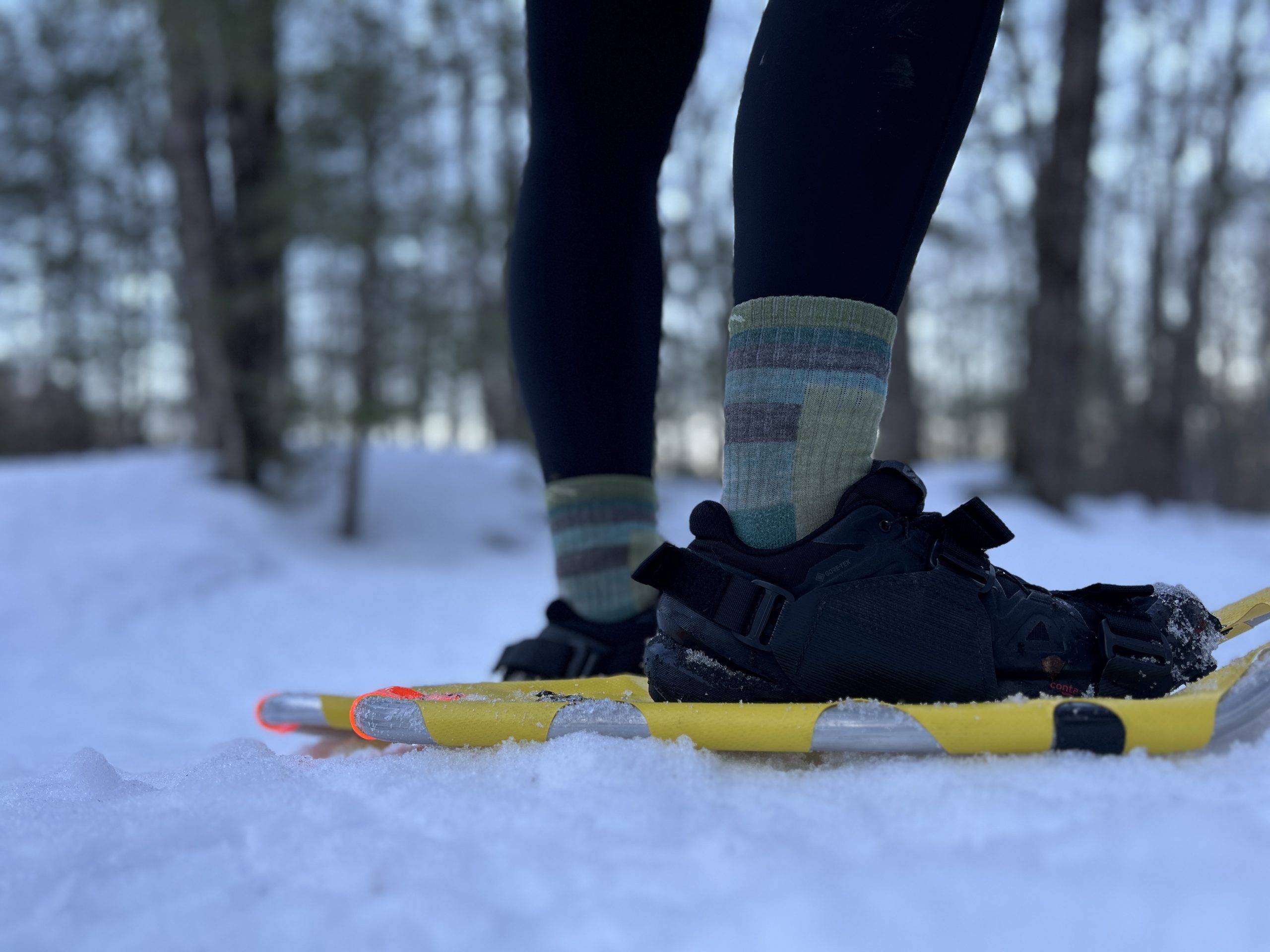
The fully customizable Dion 132s are great snowshoes for the ultra-athlete, trail runner, or anyone looking to get into winter trail racing. Photo: Rebecca Sperry/The Inertia
Snowshoe Traction
The final feature to look at when choosing a pair of snowshoes is traction. Traction, simply put, is designed to help you ascend or descend trails and navigate icy terrain.
There are a few options in terms of traction and choosing the right one can mean the difference between making it up and down a mountain safely or not. Snowshoes designed for steep terrain typically utilize some combination of toe and heel crampons, side rails (traction bars), and brake bars.
Side rails and brake bars are usually found on higher-end snowshoes, whereas most mid-range snowshoes come with toe and heel crampons.
Best Snowshoes: Final Thoughts
In summary, there is something out there for everyone. For individuals looking for the best bang for their buck and planning on hitting flat or rolling trails, we recommend the MSR Lightning Trail snowshoe. If you’re expecting to spend an exorbitant amount of time breaking trail on steep or rolling terrain, perhaps you want to upgrade to our best high-performing snowshoes, the MSR Lightning Ascents.
Or maybe your winter recreation looks a lot more like running 10ks on groomed trails. The Dion 121 QuickFit Binding/Deep Cleats will have you gliding across the trails without having to compromise speed for floatation.
Like a moose with a muffin, if you give a hiker snowshoes, she’ll need some boots to go with them. Find the perfect pair with our Best Hiking Boots guide. Boots not your thing? Try Hiking Shoes instead. For more gear reviews and features on The Inertia, click here.
Return to Comparison Table | Return to Top Picks



